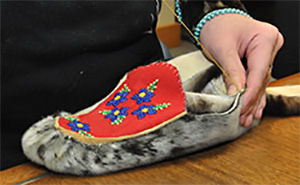
New Study on Definition of "Alaska Native" ReleasedStudy focuses on eligibility of future generations of Natives to hunt marine mammals
October 18, 2016
The definition under the Marine Mammal Protection Act (MMPA) allows only Natives with 1/4 blood quantum or more to hunt or use marine mammals for food or clothing and arts and crafts.
The study, conducted by Maritime Anthropologist Dr. Steve Langdon through Sealaska Heritage, does not make any recommendations but rather lays out several approaches the Native community may want to consider to protect their descendants' hunting rights, said SHI President Dr. Rosita Worl, who will present the study, Determination of Alaska Native Status under the Marine Mammal Protection Act, to the Alaska Federation of Natives (AFN) Board of Directors this week. AFN has not taken a position on changing the eligibility or maintaining the status quo. The study also brings to light data that might alarm some sectors of the Native community, because findings indicate among other things that the proportion of the Alaska Native population becoming ineligible to hunt marine mammals under current agency enforcement policies is rising at an accelerating rate, Worl said. "The result may be that in some communities especially around the Gulf of Alaska there may be few individuals eligible to hunt or utilize marine mammals in the not too distant future," said Worl, who emphasized that any decision to maintain the status quo or to advance an alternative eligibility requirement will remain with the Native community. The issue stems from the way the federal government defines who is an Alaska Native and consequently who is eligible to hunt marine mammals, which are an extremely important component of Alaska Native life and the basis of rich cultural traditions of dance, song, oral traditions, ceremony and ritual. Marine mammals also play a significant role in food security and provide a source of revenue through the sale of arts and craft in areas where little income opportunities are available. Federal agencies that manage hunting under the MMPA-which allows Alaska Natives to take marine mammals for subsistence purposes and to create handicrafts and clothing-have defined an Alaska Native as a person who is 1/4 degree or more Alaska Indian, Eskimo and/or Aleut blood or who was originally enrolled as an Alaska Native under the Alaska Native Claims Settlement Act. Concerned about the diminishing Native blood quantum, the declining number of Alaska Natives who meet the MMPA eligibility, and the increasing number of younger hunters and craftspeople who do not meet the 1/4 blood quantum, a Native regional corporation at the AFN 2010 convention proposed a resolution to change the definition of "Alaska Native" to include lineal Alaska Native descendants of less than 1/4 blood quantum. AFN referred the resolution to its Subsistence Committee, and after conferring with the Indigenous People's Council for Marine Mammals (IPCoMM), a statewide Native organization that focuses on marine mammal issues, the committee requested that the Sealaska Heritage Institute conduct the study and that people from coastal regions and villages contribute to it. Langdon, a senior research fellow at SHI who served as the principal investigator, collected qualitative data based on interviews and comments, numerical data from various sources, and regional hub tribal perspectives obtained through interviews with tribal leaders. Much of the numerical data were derived from statistics collected by the Bureau of Indian Affairs from 2006-2016 on new Alaska Native enrollees. Applicants to the BIA who can demonstrate Alaska Native ancestry are eligible for services regardless of blood quantum. Among the findings, nearly 20,000 Alaska Natives of less than 1/4 blood quantum were enrolled during that period. In the coastal regions where Alaska Natives are eligible to harvest marine mammals, the rate of newly enrolled Natives under 1/4 blood quantum was nearly 30 percent, and regions in the Gulf of Alaska had the highest percentages, which ranged from 56-59 percent. The data indicate that the proportion of the Alaska Native population falling below the 1/4 blood quantum has been increasing for some time and that descendants of Alaska Natives living in regions in the Gulf of Alaska will be most prone to losing eligibility to hunt marine mammals in the future. The study also included interviews with Alaska Natives, who varied on whether the definition should be changed. Some people were deeply concerned about their inability to pass on their cultural traditions and to have access to marine mammals for food in the future, while others stated that a proposal to change the definition could lead to unanticipated and detrimental outcomes. In her presentation to the AFN board, Worl will lay out the study and the possible approaches the Native community might consider if they elect to change the status quo. The study was funded by Afognak Native Corporation, Native Village of Afognak, Chugach Alaska Corporation, Koniag Incorporated, NANA, North Slope Borough, Sealaska and Sealaska Heritage Institute. SHI commissioned the study as part of its advocacy effort to promote Alaska Native arts, cultures, history and education statewide. Through that effort, the institute conducts social scientific and public policy research with its staff anthropologists and affiliates who serve as senior research fellows.
On the Web:
Editing by Mary Kauffman, SitNews Source of News:
Representations of fact and opinions in comments posted are solely those of the individual posters and do not represent the opinions of Sitnews.
|
|||
